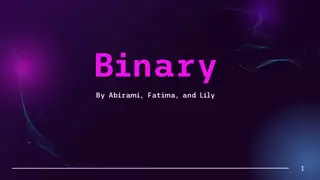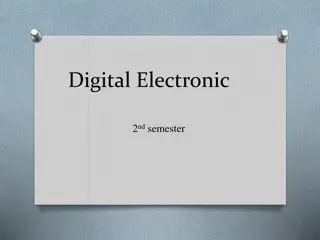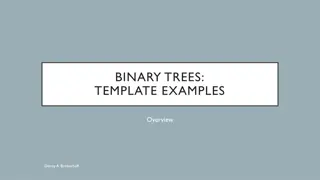Binary Codes and Their Applications
Binary coding is crucial for digital systems as they understand only 0s and 1s. This process converts information into binary language for processing by digital circuits. Different types of binary codes like weighted codes and BCD codes are used for error correction, digital communication, and compu
7 views • 20 slides
Binary Counters and Types of Counters
Binary counters are registers used to count clock pulses, while binary counters follow the binary number sequence. There are two types of counters: serial/asynchronous counters and parallel/synchronous counters. Serial counters change output flip-flop to next flip-flop, requiring minimal hardware bu
13 views • 21 slides
Non-Weighted Codes and Excess-3 Code in Binary Systems
Explore non-weighted binary codes like Excess-3 code, learn how to convert decimal numbers to XS-3 code, advantages and disadvantages of BCD codes, and steps to convert Excess-3 code to binary. Discover the intricacies of binary coding systems with practical examples.
6 views • 55 slides
Binary Number System and its Applications
Explore the world of binary numbers with insights on what binary is, its significance in computing, conversion methods between binary and decimal, hexadecimal number system, and binary arithmetic operations. Dive into the foundations of digital communication through the language of zeros and ones.
1 views • 24 slides
Binary Arithmetic
Explore the world of binary arithmetic, including addition, subtraction, multiplication, and division. Learn the rules and examples of performing basic binary operations efficiently. Understand how to convert binary numbers to decimal equivalents. Enhance your understanding with visual explanations
0 views • 51 slides
ROC Curves in Multiclass Classification
ROC curves are extended to multiclass classification to evaluate the performance of models in scenarios such as binary, multiclass, and multilabel classifications. Different metrics such as True Positive Rate (TPR), False Positive Rate (FPR), macro, weighted, and micro averages are used to analyze t
3 views • 8 slides
Binary Code and its Conversion
Computers rely on binary code, consisting of 0s and 1s, to communicate. Learn how to recognize, convert denary numbers to binary, and understand the basics of the computer language. Discover how to create a table for conversion and practice converting numbers to binary in this informative guide.
1 views • 26 slides
Binary Codes and Self-Complementing Codes
The concept of binary codes, including Binary Coded Decimal (BCD) codes, and self-complementing codes is explored in this informative content. Learn about how decimal numbers are represented in binary form, the structure of BCD codes, and the properties of self-complementing codes like 2421 and Exce
4 views • 34 slides
Binary Coded Decimal (BCD) and Excess-3 Code
Binary Coded Decimal (BCD) is a binary code used to represent decimal numbers, with the popular 8421 BCD code and its conversion process explained. Additionally, Excess-3 Code, another BCD code, is detailed with an example of finding its code for a given decimal number. Different BCD codes like 4221
0 views • 11 slides
Binary Code and Color Conversion
Delve into the fascinating world of binary code and learn how it works to represent data digitally. Discover the process of decoding binary pulses into colored pixels, using binary sequences to identify colors, and practicing digital-analog conversion through logic maps. Explore the language of bina
1 views • 20 slides
Recover Lost Funds From Binary Options Fraud Brokers
Are you a victim of a binary options fraud? You can fight back and recover your funds. Report to MychargeBack today! We have helped thousand of binary options fraud victims to get their money back. You can get your funds back from binary options scam
0 views • 15 slides
IP Addressing and Conversion from Binary to Decimal
Learn about IP addressing, including binary notation, dotted-decimal notation, and the process of converting binary numbers to decimal. Explore the unique features of IP addresses and the steps involved in converting binary to decimal systematically.
5 views • 47 slides
Overview of Fingerprint Classification and Cataloguing Methods
Explore the basics of fingerprint classification, including Henry Classification and NCIC Classification systems. Learn about the importance of classification in establishing protocols for searching and comparison. Discover the components of Henry Classification, such as primary, secondary, sub-seco
2 views • 21 slides
Binary Heaps: Efficient Data Structure for Priority Queue Operations
Explore the concept of binary heaps, a specialized type of binary tree that allows for quick retrieval of the smallest (or largest) element. Learn how binary heaps excel in finding the minimum value, essential for priority queue applications in operating systems, event simulations, and more. Compare
2 views • 34 slides
Binary Logic Systems in Documentation
Binary logic systems play a crucial role in documentation for individuals with diverse backgrounds such as management, process designers, operations staff, maintenance technicians, and more. These systems, depicted in binary logic diagrams, provide a clear and concise representation for various prof
6 views • 16 slides
Binary Number System in Mathematics
Delve into the intricacies of the binary number system with this comprehensive guide. Learn how binary numbers are formed, and master the conversion techniques between binary and decimal numbers. Discover the fascinating world of binary fractions and the algorithms for converting decimal numbers to
0 views • 20 slides
Unveiling the Progenitors of Stripped Envelope Supernovae (SNe)
The mechanism behind the stripping of stripped-envelope SNe remains a key question linked to their progenitors. Various mechanisms such as Single Star Progenitors, Binary Star Progenitors, Stellar Winds, and Close Binary Interactions are thought to dominate the stripping process. Observations of Typ
0 views • 12 slides
Introduction to Binary Arithmetic for Digital Electronics
Binary arithmetic is fundamental in digital electronics, involving addition, subtraction, and multiplication of binary numbers. This guide explains the rules and examples of binary arithmetic operations, such as binary addition and subtraction, along with detailed steps and illustrations for better
0 views • 21 slides
Binary and Numeric Systems in Computing
Delve into the world of binary systems, binary numbers, base conversions, powers of 2, arithmetic operations with binary and octal numbers, and multiplication principles in computing. Learn how to compute values and conversions in various number systems efficiently.
2 views • 41 slides
Binary Codes and Character Coding Techniques
Binary codes, such as ASCII and EBCDIC, are crucial in representing data in computers and digital systems. They play a key role in error detection and data encoding. This article discusses the basics of binary coding, various types of binary codes, character coding techniques like ASCII and EBCDIC,
3 views • 22 slides
Binary Addition Circuits in Computing
Explore the concepts of half adders, full adders, and binary addition circuits used in computer systems. Learn how binary digits are represented as logic levels to perform addition operations. Dive into the working principles of half adders, truth tables, formulas, and circuit diagrams for binary ad
0 views • 15 slides
Number Representation and Conversion
Learn how to convert between decimal and binary number representations. Discover the process from decimal to binary by dividing repeatedly by 2, and from binary to decimal by summing the powers of 2. Explore the simplicity of converting between base 16 and base 2, and practice binary addition with e
0 views • 27 slides
Binary Representation of Numbers with Fractions
Learn how to represent numbers with fractions in binary form. Discover the process of converting real numbers, like 5.75, into binary by separating the integer and fraction parts. Explore the method of obtaining the binary representation of the fraction through division by specific decimal values. U
1 views • 21 slides
Binary Trees in Java
Binary trees are a fundamental data structure in Java composed of nodes with values and references to left and right children. Nodes have specific relationships like parent-child, ancestor-descendant, and sibling. The size and depth of a binary tree determine its structure, and balancing is essentia
0 views • 19 slides
Binary Numbers and Computer Data Representation
A computer stores information digitally as binary numbers, where data is broken down into pieces and represented as numbers. The binary system uses 0s and 1s to encode information, with each bit representing on/off states. This system is crucial for converting data into machine language. Binary numb
0 views • 14 slides
Conversion from Decimal Numeration to Binary, Octal, Hexadecimal
In digital electronic studies, understanding the conversion from decimal numeration to binary, octal, and hexadecimal systems is crucial for computer science enthusiasts. This process involves repeated cycles of divisions to break down the decimal number into binary, octal, or hexadecimal place weig
0 views • 15 slides
Binary Numbers
The content delves into the basics of binary numbers, discussing the binary digit as the fundamental unit of computer information. It covers finite-precision numbers and the radix system, including conversion between decimal and binary. Addition concepts, system conversions, and group practice exerc
0 views • 7 slides
Binary Numbers
Dive into the world of binary numbers, exploring how they can be used efficiently for counting and mastering the art of conversion between binary and decimal numbers. Discover the logic behind binary digits and how they power modern technology and computing systems. Unveil the simplicity and eleganc
0 views • 14 slides
Teaching KS3 Computing
Today's session covers binary numbers, teaching how they are represented, and enabling students to perform binary-to-decimal conversions with practical examples and activities. Explore binary counting exercises, conversion techniques, and practice exercises to enhance understanding. Activities inclu
0 views • 20 slides
Counting in Binary
Delve into the fundamentals of binary counting, denary representation, and conversion methods between the two number systems. Explore the significance of digits, understand how numbers are broken down, and learn the step-by-step processes for converting binary to denary and vice versa. Master the ar
0 views • 31 slides
Digital Electronic
Israa Hussein's 2nd semester lecture on digital electronic systems explores the comparison between binary and decimal numeration systems. Delve into the representation of quantities in binary, the ease of materializing 0 and 1 in electronics, and the binary equivalent of numbers like 35. Understand
0 views • 18 slides
Binary Representation Basics
Delve into the fundamentals of binary number representation as explained in the instructional material from William Marsh School of Electronic Engineering and Computer Science at Queen Mary University of London. Learn how to count and perform arithmetic in binary, understand the significance of bina
0 views • 34 slides
FIRST MAGNETAR IN A BINARY SYSTEM
In a groundbreaking discovery, a new magnetar candidate was detected in a binary system by the Swift observatory. This young, highly magnetized neutron star orbits a Be star, hinting at a possible binary nature. Spectroscopic analysis revealed long-term variability and a mild eccentricity in the orb
0 views • 7 slides
Introduction to Classification Trees: CART Algorithm Overview
Classification trees, specifically the CART (Classification and Regression Trees) algorithm, are powerful tools for analyzing data and making predictions. By recursively partitioning data based on predictor values, classification trees aim to create nodes that are as different as possible in terms o
0 views • 13 slides
8086 Architecture and Binary Numbering System
Explore the fundamentals of 8086 architecture and binary numbering system. Delve into how computers interpret binary digits, the significance of bits, nibbles, bytes, words, and double words, and the conventions for denoting binary numbers. Learn binary addition and subtraction with examples.
0 views • 6 slides
Practice Now: Binary & Denary Conversion
Convert binary numbers to denary and vice versa using mini whiteboards or scrap paper. Master converting binary numbers like 10011001 to denary, 103 to binary, 5C to binary, and F9 to denary. Increase your computational skills with these exercises.
2 views • 25 slides
RECURSIVE DATATYPES
Recursive datatypes play a crucial role in defining complex data structures such as binary trees. This content delves into the concept of recursive datatypes, specifically focusing on binary trees and their node structures. Each node in a binary tree contains a value and two other binary trees, illu
0 views • 10 slides
Understanding Binary Codes in Digital Electronics
Explore the world of binary codes in digital electronics, including BCD, Excess-3, Gray codes, and ASCII codes. Learn about the advantages of binary coding and the classification of binary codes into weighted, non-weighted, BCD, alphanumeric, error detecting, and error correcting codes.
0 views • 14 slides
Binary Trees Template Examples and Implementation Guide
Delve into the world of binary trees with detailed examples and a comprehensive guide on creating, manipulating, and removing nodes in binary tree structures. Learn the step-by-step process for implementing binary trees and efficiently managing tree nodes. Explore various scenarios for removing node
0 views • 10 slides
Teaching Computing: Binary Arithmetic and Python Programming Overview
This session introduces GCSE students to binary arithmetic theory and practical Python programming skills. Topics covered include adding binary numbers, binary shifts, logic diagrams, CPU architecture, arrays, and more. Prepare for GCSE programming with longer tasks and consolidate understanding thr
0 views • 22 slides







































